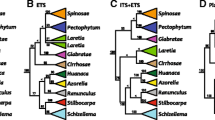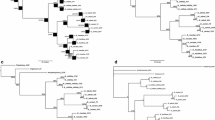Abstract
Hierarchical patterns inSilene sect.Sedoideae were investigated using random amplified polymorphic DNA (RAPD), nucleotide sequences of the internal transcribed spacer (ITS) regions of the 18S–28S nuclear ribosomal DNA, and discrete morphological characters. All data sets firmly supported the species recognized. The RAPD data offered the best resolution at the intraspecific level, supporting the current intraspecific classifications ofS. sedoides andS. integripetala. The ITS sequences and the morphological data gave poor resolution within species, and the three data sets disagreed about the relationships among species. The signal from the RAPD data was strongest and remained when the total data set was analysed. The three data sets all support an amphiploid origin ofS. aegaea, with the strongest evidence from the ITS sequences. Incongruences among data sets as well as merits and shortcomings of each are discussed. The robustness of the results can be evaluated using perturbations of data, i.e., bootstrap and jackknife of taxa and characters. These methods should not be taken as methods of statistical inference at the taxonomic level, because unbiased sampling appears impossible. RAPD data, however, come close to being suitable for statistical estimation of hierarchies at the genome level, but several methodological problems have to be solved.
Similar content being viewed by others
References
Adams, R. P., Demeke, T., 1993: Systematic relationships inJuniperus based on random amplified polymorphic DNAs (RAPDs). — Taxon42: 553–571.
Albert, V. A., Mishler, B. D., Chase, M. W., 1992: Character-state weighting for restriction site data in phylogenetic reconstruction, with an example from chloroplast DNA. — InSoltis, P. S., Soltis, D. E., Doyle, J. E., (Eds): Molecular systematics of plants, pp. 369–401. — New York: Chapham & Hall.
Arnold, E. N., 1981: Estimating phylogenies at low taxonomic levels. — Z. Zool. Syst. Evolutionsforsch.19: 1–35.
Baldwin, B. G., 1992: Phylogenetic utility of the internal transcribed spacers of nuclear ribosomal DNA in plants: an example from theCompositae. — Molec. Phylogenet. Evol.1: 3–16.
—, 1993: Molecular phylogenetics ofCalycadenia (Compositae) based on ITS sequences of nuclear ribosomal DNA: chromosomal and morphological evolution reexamined. — Amer. J. Bot.80: 222–238.
Baum, D. A., Sytsma, K. J., Hoch, P. C., 1994: A phylogenetic analysis ofEpilobium (Onagraceae) based on nuclear ribosomal DNA sequences. — Syst. Bot.19: 363–388.
Bowditch, B. M., Albright, D. G., Williams, J. K. G., Braun, M. J., 1993: Use of randomly amplified polymorphic DNA markers in comparative genome studies. — Meth. Enzymol.224: 294–309.
Buren, R. Van, Harper, K. T., Andersen, W. R., Stanton, D. J., Seyoum, S., England, J. L., 1994: Evaluating the relationship of autumn buttercup (Ranunculus acriformis var.aestivalis) to some close congeners using random amplified polymorphic DNA. — Amer. J. Bot.81: 514–519.
Caetano-Anollés, G., Bassam, B. J., Gresshoff, P. M., 1991: DNA amplification fingerprinting using very short arbitrary oligonucleotide primers. — Bio/Technology9: 553–556.
Carpenter, J. M., 1992: Random cladistics. — Cladistics8: 147–153.
Chapco, W., Ashton, N. W., Martel, R. K. B., Anonishyn, N., Crosby, W. L., 1992: A feasability study of the use of random amplified polymorphic DNA in the population genetics and systematics of grasshoppers. — Genome35: 569–574.
Clark, A. G., Lanigan, C. M. S., 1993: Prospects for estimating nucleotide divergence with RAPDs. — Molec. Biol. Evol.10: 1096–1111.
Crawford, D. J., Brauner, S., Cosner, M. B., Stuessy, T. F., 1993: Use of RAPD markers to document the intergeneric hybrid ×Margyracaena skottsbergii (Rosaceae) on the Juan Fernandez islands. — Amer. J. Bot.80: 89–92.
Cronquist, A., 1978: Once again, what is a species? — Beltsville Symp. Agric. Res.2: 3–20.
Demeke, T., Adams, R. P., Chibbar, R., 1992: Potential taxonomic use of random amplified polymorphic DNA (RAPD): a case study inBrassica. — Theor. Appl. Genet.84: 990–994.
Ellsworth, D. L., Rittenhouse, K. D., Honeycutt, R. L., 1993: Artifactual variation in randomly amplified polymorphic DNA banding patterns. — Biotechniques14: 214–217.
Farris, J. S., 1989: The retention index and the rescaled consistency index. — Cladistics5: 417–419.
Felsenstein, J., 1985: Confidence limits on phylogenies: an approach using the bootstrap. — Evolution39: 783–791.
Gagnon, J., Roth, J. M., Carroll, M., Hofmann, R., Haycock, K. A., Plamondon, J., Feldman, D. S. Jr.,Simpson, J., 1991: SuperANOVA — accessible general linear modeling, ver. 1.11. — Ohio: Abacus Concepts.
Greuter, W., 1972: The relict element of the flora of Crete and its evolutionary significance. — InValentine, D. H., (Ed.): Taxonomy, phytogeography and evolution, pp. 161–177. — New York: Chapham & Hall.
Hennig, W., 1966: Phylogenetic systematics. — Urbana: University of Illinois Press.
Heusden, A. W. Van, Bachmann, K., 1992a: Genotype relationships inMicroseris elegans (Asteraceae, Lactuceae) revealed by DNA amplification from arbitrary primers (RAPDs). — Pl. Syst. Evol.179: 221–233.
—, —, 1992b: Nuclear DNA polymorphisms among strains ofMicroseris bigelovii (Asteraceae: Lactuceae) amplified from arbitrary primers. — Bot. Acta105: 331–336.
Hilu, K. W., 1994: Evidence from RAPD markers in the evolution ofEchinochloa millets (Poaceae). — Pl. Syst. Evol.189: 247–257.
Holmgren, K. P., Holmgren, H. N., Barnett, L. C., 1990: Index Herbariorum 1: The herbaria of the world, 8th edn. — Regnum Veg.120.
Houten, W. H. J.Van, Scarlett, N., Bachmann, K., 1993: Nuclear DNA markers of the Australian tetraploidMicroseris scapigera and its North American diploid relatives. — Theor. Appl. Genet.87: 498–505.
Hsü, K. J., 1972: When the Mediterranean dried up. — Sci. Amer.227: 27–36.
Kazan, K., Manners, J. F., Cameron, D. F., 1993: Genetic relationships and variation in theStylosanthes guianensis species complex assessed by random amplified polymorphic DNA. — Genome36: 43–49.
Kesner, M. H., 1994: The impact of morphological variants on a cladistic hypothesis with an example from a mycological data set. — Syst. Biol.43: 41–57.
Kim, K. -J., Jansen, R. K., 1994: Comparisons of phylogenetic hypotheses among different data sets in dwarf dandelions (Krigia, Asteraceae): additional information from internal transcribed spacer sequences of nuclear ribosomal DNA. — Pl. Syst. Evol.190: 157–185.
Kluge, A. G., Wolf, A. J., 1993: Cladistics: what's in a word? — Cladistics9: 183–199.
Lecointre, G., Philippe, H., Lê, H. L. V., Guyader, H. L., 1994: How many nucleotides are required to resolve a phylogenetic problem? The use of a new statistical method applicable to available sequences. — Molec. Phylogenet. Evol.3: 292–309.
Lidén, M., Axberg, T., Fukuhara, T., 1995: Phylogeny ofCorydalis: molecular and morphological data. — Pl. Syst. Evol., Suppl.9: 183–188.
Luque, T., Ruiz, C., Avalos, J., Calderón, I. L., Figueroa, M. E., 1995: Detection and analysis of genetic variation inSalicornieae (Chenopodiaceae) using random amplified polymorphic DNA (RAPD) markers. — Taxon44: 53–63.
Lynch, M., 1990: The similarity index and DNA fingerprinting. — Molec. Biol. Evol.7: 478–484.
Macpherson, J. M., Eckstein, P. E., Scoles, G. J., Gajadhar, A. A., 1993: Variability of the random amplified polymorphic DNA assay among thermal cyclers, and effects of primer and DNA concentration. — Molec. Cell. Probes7: 293–299.
Marsolais, J. V., Pringle, J. S., White, B. N., 1993: Assessment of random amplified polymorphic DNA (RAPD) as genetic markers for determining the origin of interspecific lilac hybrids. — Taxon42: 531–537.
Matsunaga, S., Hizume, M., Kawano, S., Kuroiwa, T., 1994: Cytological analyses inMelandrium album. Genome size, chromosome size and flourescence in situ hybridization. — Cytologia59: 135–141.
McDade, L., 1990: Hybrids and phylogenetic systematics. I. Patterns of character expression in hybrids and their implications for cladistic analysis. — Evolution44: 1685–1700.
—, 1992: Hybrids and phylogenetic systematics. II. The impact of hybrids on cladistic analysis. — Evolution46: 1329–1346.
Meunier, J. R., Grimont, P. A. D., 1993: Factors affecting reproducibility of random amplified polymorphic DNA fingerprinting. — Res. Microbiol.144: 373–379.
Oxelman, B., 1995: A revision of theSilene sedoides-group. — Willdenowia25: 143–169.
—, 1995: Generic boundaries in the tribeSileneae (Caryophyllaceae) as inferred from nuclear rDNA sequences. — Taxon44: 525–542.
Patterson, C., 1988: Homology in classical and molecular biology. — Molec. Biol. Evol.5: 603–625.
Puterka, G. J., Black IV, W. C., Steiner, W. M., Burton, R. L., 1994: Genetic variation and phylogenetic relationships among worldwide collections of the Russian Wheat Aphid,Diuraphis noxia (Mordvilko), inferred from allozyme and RAPD-PCR markers. — Heredity70: 604–618.
Rechinger, K. H., 1967: Die pflanzengeographische Stellung Kytheras und Antikytheras. — Boissiera13: 197–201.
Runemark, H., 1969: Reproductive drift, a neglected principle in reproductive biology. — Bot. Not.122: 90–129.
Sanderson, M.J., 1989: Confidence limits on phylogenies: the bootstrap revisited. — Cladistics5: 113–129.
Sang, T., Crawford, D. J., Kim, S.-C., Stuessy, T. F., 1994: Radiation of the endemic genusDendroseris (Asteraceae) on the Juan Fernandez islands: evidence from sequences of the ITS regions of nuclear ribosomal DNA. — Amer. J. Bot.81: 1494–1501.
Savard, L., Michaud, M., Bousquet, J., 1993: Genetic diversity and phylogenetic relationships between birches and alders using ITS, 18S rRNA, and rbcL gene sequences. — Molec. Phylogenet. Evol.2: 112–118.
Schierwater, B., Ender, A., 1993: Different thermostable DNA polymerases may amplify different RAPD products. — Nucl. Acids Res.21: 4647–4648.
Sheen, J.-Y., Seed, B., 1988: Electrolyte gradient gels for DNA sequencing. — Bio/Techniques6: 942–943.
Siddall, M. E., 1995: Another monophyly index: revisiting the jackknife. — Cladistics11: 33–56.
Smith, J.J., Scott-Craig, J.S., Leadbetter, J.R., Bush, G.L., Roberts, D.L., Fulbright, D.W., 1994: Characterization of random amplified polymorphic DNA (RAPD) products fromXanthomonas campestris and some comments on the use of RAPD products in phylogenetic analysis. — Molec. Phylogenet. Evol.3: 135–145.
Soltis, P. S., Soltis, D. E., Doyle, J. E., (Eds), 1992: Molecular systematics of plants. — New York: Chapham & Hall.
Stammers, M., Harris, J., Evans, G. M., Hayward, M. D., Forster, J. W., 1995: Use of random PCR (RAPD) technology to analyse phylogenetic relationships in theLolium/Festuca complex. — Heredity74: 19–27.
Stevens, P. F., 1991: Character states, morphological variation, and phylogenetic analysis: a review. — Syst. Bot.16: 553–583.
Suh, Y., Thien, L. B., Reeve, H. E., Zimmer, E. A., 1993: Molecular evolution and phylogenetic implications of internal transcribed spacer sequences of ribosomal DNA inWinteraceae. — Amer. J. Bot.80: 1042–1055.
Swofford, D., 1991: When are phylogeny estimates from molecular and morphological data incongruent. — InMiyamoto, M. M., Cracraft, J., (Eds): Phylogenetic analysis of DNA sequences, pp. 295–333. — New York: Oxford University Press.
—, 1993: PAUP: Phylogenetic analysis using parsimony. — Champaign: Illinois Natural History Survey.
Weeden, N. F., Timmerman, G. M., Hemmat, M., Kneen, B. E., Lodhi, M. A., 1992: Inheritance and reliability of RAPD markers. — In: Proceedings of the Joint Plant Breeding Symposium Series. Applications of RAPD technology to plant breeding, pp. 12–17. — Minneapolis, MN: Crop Science Society of America, American Society for Horticultural Science and American Genetic Association.
Welsh, S. L., McClelland, M., 1990: Fingerprinting genomes using PCR with arbitrary primers. — Nucl. Acids Res.18: 7213–7218.
Williams, J. G. K., Kubelik, A. R., Livak, K. J., Rafalski, J. A., Tingey, S. V., 1990: DNA polymorphisms amplified by arbitrary primers are useful as genetic markers. — Nucl. Acids Res.18: 6531–6535.
—, 1993: Genetic analysis using random amplified polymorphic DNA markers. — Meth. Enzymol.218: 704–740.
Wojciechowski, M. F., Sanderson, M. J., Baldwin, B. G., Donoghue, M. J., 1993: Monophyly of aneuploidAstragalus (Fabaceae): evidence from nuclear ribosomal DNA internal transcribed spacer sequences. — Amer. J. Bot.80: 711–722.
Yang, X., Quiros, C., 1993: Identification and classification of celery cultivars with RAPD markers. — Theor. Appl. Genet.86: 205–212.
Yoon, C. S., 1992: Examination of parameters affecting polymerase chain reaction in studying RAPD. — Korean J. Mycol.20: 315–323.
Author information
Authors and Affiliations
Rights and permissions
About this article
Cite this article
Oxelman, B. RAPD patterns, nrDNA ITS sequences and morphological patterns inSilene sectionSedoideae (Caryophyllaceae). Pl Syst Evol 201, 93–116 (1996). https://doi.org/10.1007/BF00989054
Received:
Revised:
Accepted:
Issue Date:
DOI: https://doi.org/10.1007/BF00989054




